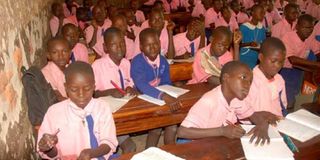Authorities decry shortage of teachers

Crowded. Pupils attend classes in one of the schools under Universal Primary Education in Acholi Sub-region. Monitor photo
Dokolo District is grappling with an acute shortage of teachers, which authorities say is affecting performance and management of government schools. At least 1,091 teachers are required to teach in 60 government primary schools in Dokolo District. However, currently, there are only 740 teachers.
The national teacher to pupil ratio stands at 1:50 but for Dokolo, it is at 1:90. The District Education Officer (DEO), Mr David Eryatu, said there are 174 females out of 740 teachers the district.
“As of now, there are only 28 substantial head teachers in Dokolo and 42 are caretakers. Before this quarter ends, I pray that all these head teachers are recruited as substantial head teachers,” he told Daily Monitor in an interview on Monday, confirming the staffing gap of 351 teachers.
Female teachers
In the recruitment plan, Mr Eryatu explained that the district is planning to recruit more female teachers.
“Worst of all is that Dokolo has only 174 female teachers. There are 35,000 female pupils and each female teacher has to care for more than 200 pupils,” the DEO said.
The Dokolo Woman Member of Parliament, Ms Cecilia Atim Ogwal, noted that having more female teachers would encourage girls to stay in school. “We want affirmative action on the promotion of female teachers. When there are many female teachers, they can encourage our girls to continue with their education,” Ms Ogwal said.
The Local Government Management and Service Delivery Operational Manual of 2009 spells out the minimum standards for schools. Among them is for one teacher to teach 53 pupils; 55 pupils to study in one classroom; one desk for three pupils and a latrine stance for 40 pupils.
When government introduced Universal Primary Education (UPE) in 1997, the intention was to offer free primary school education for four children per family. Enrolment in UPE schools grew from 3.1 million pupils to the current 8.6 million, according to the ministry of Education and Sports’ fact sheet 2002-2016.
Under the programme, government introduced the capitation grant, which these schools use to buy books, writing tools and chalk.
The schools receive Shs10,000 for each pupil, disbursed three times a year.



